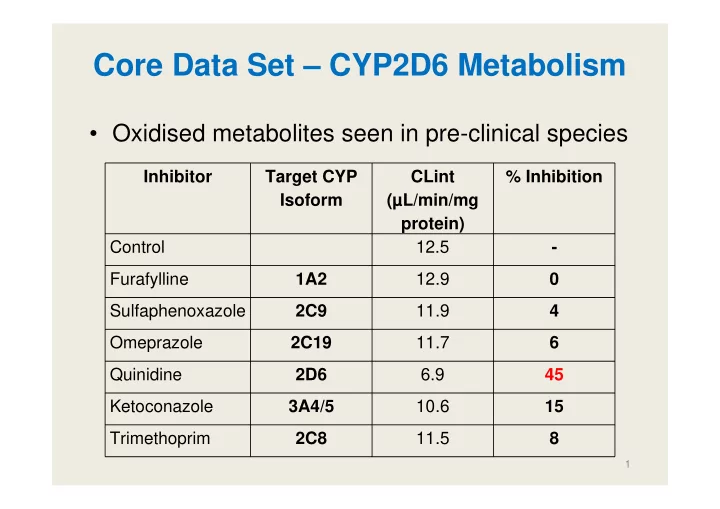

Core Data Set – CYP2D6 Metabolism • Oxidised metabolites seen in pre-clinical species Inhibitor Target CYP CLint % Inhibition Isoform (µL/min/mg protein) Control 12.5 - Furafylline 1A2 12.9 0 Sulfaphenoxazole 2C9 11.9 4 Omeprazole 2C19 11.7 6 Quinidine 2D6 6.9 45 Ketoconazole 3A4/5 10.6 15 Trimethoprim 2C8 11.5 8 1
Opinion of the group: • 2D6 metabolism associated with significant clinical experience, particularly with respect to poor metabolizers • The consensus of the group was to identify 2D6 PMs • Prospective genotyping proposed • Possible design: • Volunteers with increasing dose • Exclude PMs initially • Include PMs at low dose once higher dose tolerated by EMs • Conclusion: everyone wants PM information e.g. exclude PMs from initial studies.
Variation 1 – CYP3A4/5 Metabolism • As per core set, but metabolism is via CYP3A4 Inhibitor Target CYP CLint % Inhibition Isoform (µL/min/mg protein) Control 12.5 - Furafylline 1A2 12.9 0 Sulfaphenoxazole 2C9 11.9 4 Omeprazole 2C19 11.7 6 Quinidine 2D6 10.6 15 Ketoconazole 3A4/5 6.9 45 Trimethoprim 2C8 11.5 8 3
Opinion of the group • CYP3A4/5 with poorer correlation between genotype and phenotype • As a result, the consensus of group: – Do nothing, collect DNA • If Blacks: somewhat more important for 3A5 genotyping
Variation 2 – CYP2C8 Metabolism • As per core set, but metabolism is via 2C8 Inhibitor Target CYP CLint % Inhibition Isoform (µL/min/mg protein) Control 12.5 - Furafylline 1A2 12.9 0 Sulfaphenoxazole 2C9 11.9 4 Omeprazole 2C19 11.7 6 Quinidine 2D6 10.6 15 Ketoconazole 3A4/5 10.5 15 Trimethoprim 2C8 5.6 55 5
Opinion of the group • CYP2C8 with poor-metabolizer alleles • However, limited clinical literature on the impact on drug metabolism Consensus of group: • DNA collection only, no pro-active genotyping (c.f. CYP2D6) • Weak penetrance of alleles • Do CYP2C8 genotyping, when PK or other outliers are identified later during development
Variation 3 – No Oxidised Metabolites • As per core dataset, but no oxidative metabolites seen in pre-clinical species – compound excreted unchanged in faeces Inhibitor Target CYP CLint % Inhibition Isoform (µL/min/mg protein) Control 12.5 - Furafylline 1A2 12.9 0 Sulfaphenoxazole 2C9 11.9 4 Omeprazole 2C19 11.7 6 Quinidine 2D6 6.9 45 Ketoconazole 3A4/5 10.6 15 Trimethoprim 2C8 11.5 8 7
Opinion of the group • Absence of oxidised metabolites suggests that in vitro metabolism may not be relevant in vivo Consensus: • DNA collection only, no pro-active genotyping (c.f. core case) • Some attention warranted regarding effect in relation to the UM (and PM) phenotypes, in case UMs generate oxidised metabolites in humans
Variation 4 – Reduced CYP2D6 Metabolism • As per core set, except that CYP2D6 specific metabolism is 22% (as opposed to 40%). Inhibitor Target CYP CLint % Inhibition Isoform (µL/min/mg protein) Control 12.5 - Furafylline 1A2 12.9 0 Sulfaphenoxaz 2C9 11.9 4 ole Omeprazole 2C19 11.7 6 Quinidine 2D6 9.8 22 Ketoconazole 3A4/5 11.8 5 Trimethoprim 2C8 11.5 8 9
Opinion of the group • Weak CYP2D6 metabolism, with uncertain relevance • Divergence in opinions in group: – Determine the non-metabolised clearance – 2D6 genotyping for safety issues – PMs identified later in development – Enriched studies on defined phenotypes
Transporter Studies • Increasingly, transporters implicated in drug disposition, efficacy and safety • Compound A (target organ – liver) tested for uptake in cells transfected with human OATP receptors, including known polymorphisms – Data for OATP sub-types expressed as rate of uptake into transfected cells – Data for OATP1B1 variants expressed as percentage activity of ‘wild-type’ transporter 11
OATP Transport Data OATP Sub- Rate of OATP1B1 Frequency Rate of type Uptake Variant Uptake (A.U) (A.U) Vehicle 0.8 *1a 0.56 12.5 1A2 4.5 *1b 0.26 10.2 1B1 12.5 *5 0.02 1.5 1B3 6.2 *15 0.16 4.5 2B1 3.5 • The data show significant uptake by OATP1B1, which is greatly reduced in known human variants • Some uptake is seen with other OATP sub- types 12
Opinion of the group • As yet, few examples linking genotype variants to clinical outcome • Consensus to collect DNA in phase I studies • A majority recommends prospective genotype studies in phase I • Agreement that genotyping is necessary during phase IIa efficacy studies
General aspects • Ethics committees need to understand the value of prospective DNA collection – still an issue • DMET chips – patients numbers are too small in phase I • DMET chips can be used the whole phase clinical trials • Focus is often on PMs. However, UMs important for metabolite formation (for safety) and during Phase II (for efficacy). • Clinical experience was the critical factor driving pro-active PGx in phase I
Recommend
More recommend